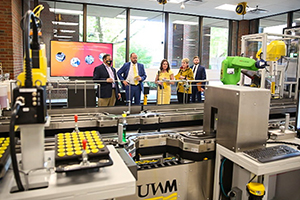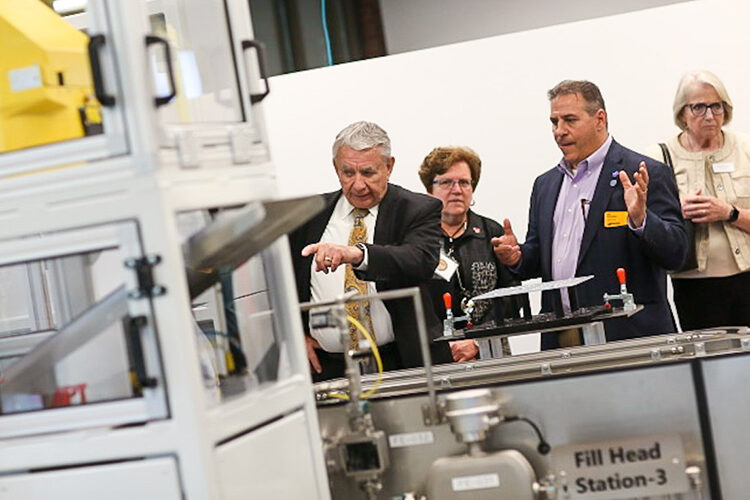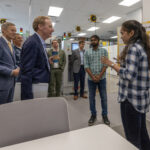Members of the Board of Regents and chancellors at other UW System universities on Thursday toured UWM’s Connected Systems Institute, which just unveiled its first industry test bed, a factory production line and its “digital twin” that will be used for learning and collaborative research. The tour was Thursday night, amid the June 3-4 regents meeting at UWM.
Together with dozens of private companies, the CSI is developing new ways to integrate digital technologies such as artificial intelligence, robotics and the data on the industrial internet of things into next-generation manufacturing. To date, CSI industry partners, contributors and collaborators have raised more than $8.3 million for the institute, which opened in 2019.
Located in the east wing of the UWM Library, CSI showcases all the enabling technologies a manufacturer needs to digitally transform and implement Industry 4.0 – the automation of traditional manufacturing, using modern smart technology. And it offers the workforce training manufacturers need to make the transition.

A state-of-the-art simulation learning environment is the key to the transition to smart factories, said UWM Chancellor Mark Mone, and UWM couldn’t have accomplished it alone. “Without industry, without government support through the (Wisconsin Economic Development Corporation), and without all the other institutions that are part of the Connected Systems Institute, we simply couldn’t deliver,” Mone said.
In fact, the concept for the CSI is the result of an ongoing conversation Mone had with a past and present CEO at Rockwell Automation – Keith Nosbusch and Blake Moret, respectively. The two executives expressed the need for their employees to become more comfortable working in a digital environment.
“Workforce development and lifelong learning are intentionally important to us,” said Moret, “because all the technology in the world will go to waste without people who understand it and are engaged in using it.”
In the next five years, manufacturing is set to change more than it has in the last 50 years because of connected technologies that analyze data streaming from factory equipment to the industrial internet of things (IIoT), said Sujeet Chand, chief technology officer of Rockwell Automation. “And we have a great ecosystem around us to help,” he said, “including a premier institute at UWM to help us with many facets of research and education that are needed for realizing the connected enterprise.”
Manufacturing is the still the backbone of Wisconsin’s economy, said Missy Hughes, CEO of WEDC. “So it’s really critical that we think about how to take that into the future. It’s places like CSI that are going to help that happen.”
Test bed innovations
The digital test bed documents the physical test bed’s behaviors so that irregularities can be spotted, but it also allows for experimentation.
For example, the conveyor line operates with a linear electromagnetic motor than generates heat, said Ilya Avdeev, UWM associate professor of mechanical engineering. The more load the conveyor moves, the more heat is generated, which is something that can be simulated on a digital twin. “Knowing what’s going to happen before you design the plan is the holy grail,” Avdeev said.
Connective technology will allow factories to include more specialized orders and profit more from e-commerce in the future, said Joe Zaccaria, program manager at Rockwell. “The test bed introduces machine learning to the production line and takes orders from SAP software, automatically generating work orders,” Zaccaria said. “No one has been able to do that yet.”
Mohammad Rahman, associate professor of mechanical engineering, and his lab members demonstrated how the robotic arms on the test bed can be manipulated from remote locations using a augmented reality program on a tablet or smartphone. Augmented reality in this environment consists of enhancing robots that exist in the real world with computer-generated replicas that a user can interact with virtually, giving researchers another way to try theories and ideas.
Integrating data
CSI also has a million-dollar data server – the test bed’s networking infrastructure hub that directs traffic from all the related operations, said Matt Eide of Heartland Business Systems. The server has integrated various products of eight business partners.
Connectivity also applies to the utility industry. In another CSI research project, Jun Zhang, UWM professor of electrical engineering and computer science, is working with We Energies to develop artificial intelligence and machine learning techniques that will predict when gas and electricity meters will need maintenance, which can minimize down time and extend the life of the meters. The researchers are able to use the meters’ real-time monitoring data that streams over the IIoT to inform the AI and use it to determine the rate of wear.
CSI’s next test bed will be focused on cybersecurity, said Kaushal Chari, dean of UWM’s Lubar School of Business and the interim executive director. “We need to ensure that automated production lines are protected and that students know how to do that.”







